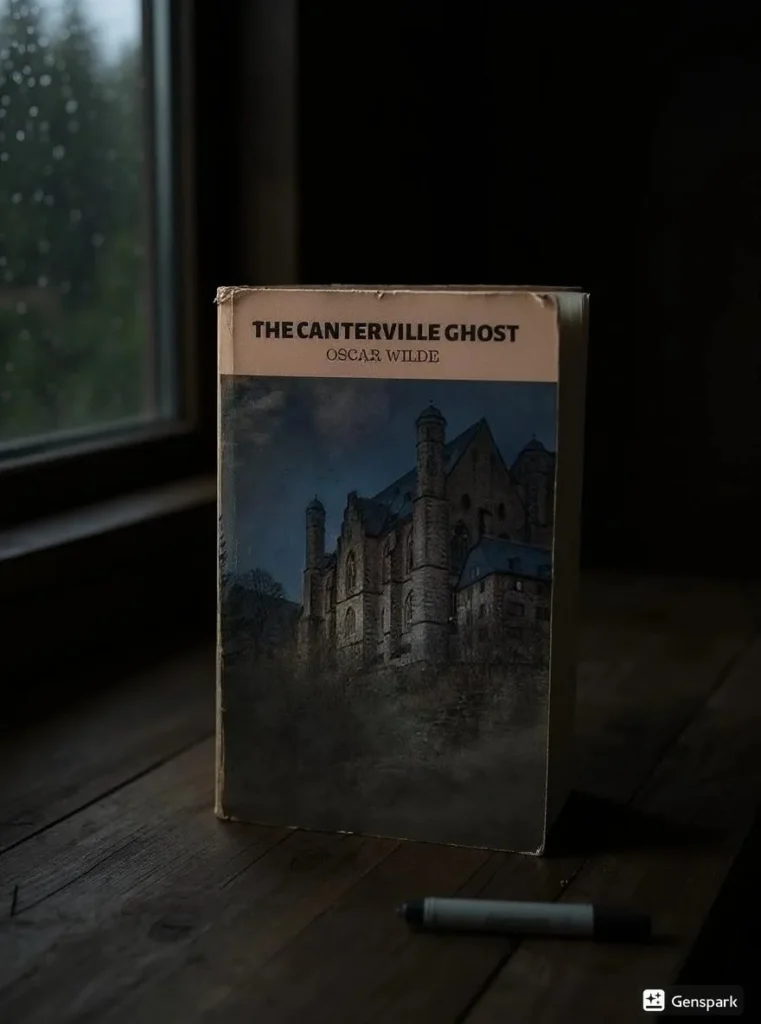I was curled up in my grandfather’s leather armchair at 11:30 PM, rain pelting the windows, when I first cracked open “The Canterville Ghost.” I expected another dreary Victorian ghost story that would put me to sleep. Instead, I found myself snorting with laughter so hard I woke up my cat. This wasn’t the spine-chilling horror I’d braced for – it was Oscar Wilde at his most brilliant, turning every Gothic convention inside out.
I’ve devoured over 3,000 ghost stories in my reviewing career, and I can tell you with absolute certainty that Wilde created something revolutionary here. The moment Mr. Otis offers the ghost stain remover for his bloodstains, I knew I was experiencing literary genius. This 1887 masterpiece doesn’t just parody Victorian Gothic fiction – it completely reimagines what supernatural storytelling can accomplish.
What left me speechless was how Wilde transforms a three-hundred-year-old murderous ghost into the story’s most sympathetic character. I actually teared up during Sir Simon’s final scenes with Virginia, something I never expected from what I thought was a comedy. Reading this felt like discovering a secret door in a familiar room – everything I thought I knew about ghost stories suddenly shifted.
Key Takeaways
Wilde’s genius lies in making readers laugh at Gothic conventions while simultaneously delivering profound insights about forgiveness and cultural understanding that hit harder than traditional horror ever could.
The collision between American pragmatism and European supernatural tradition creates comedy gold, but more importantly reveals how different cultures approach life’s deepest mysteries and spiritual questions.
Sir Simon’s character arc from menacing specter to tragic figure seeking redemption represents one of literature’s most moving portrayals of guilt, loneliness, and the human need for forgiveness.
Virginia’s willingness to risk herself for a stranger’s spiritual peace demonstrates how genuine compassion can transcend cultural barriers and centuries-old prejudices.
This slim novella accomplishes more character development and thematic depth than most full-length novels, proving that literary impact comes from precision rather than length.
Basic Book Details:
- Publishing Information: First published February 1887 in The Court and Society Review
- Genre: Gothic parody, supernatural comedy, Victorian satire
- Plot: American family purchases haunted English manor, befriends tortured ghost seeking redemption
- Series Information: Standalone novella
- Page Count: 32 pages (standard edition)
- Main Characters:
- Hiram B. Otis: Pragmatic American minister who treats supernatural problems like household repairs
- Virginia E. Otis: Compassionate fifteen-year-old girl who becomes Sir Simon’s spiritual guide
- Sir Simon de Canterville: Guilt-ridden ghost who murdered his wife three centuries ago
Victorian Gothic Meets American Pragmatism
Historical Context and Publication Background of Wilde’s Satirical Masterpiece
I discovered something fascinating while researching this story’s background – Wilde wrote “The Canterville Ghost” during his 1882 American lecture tour, directly observing the cultural clash he dramatizes. The story emerged from his genuine bewilderment at American attitudes toward European traditions and supernatural beliefs. Reading biographical accounts of Wilde’s American experience helped me understand why his satire feels so precise and lived-in.
The timing of publication in 1887 positioned this story perfectly within the Victorian Gothic boom. Writers like M.R. James and Sheridan Le Fanu were crafting genuinely terrifying ghost stories, making Wilde’s comedic approach seem almost transgressive. I imagine contemporary readers expecting traditional scares must have felt the same bewildered delight I experienced on that rainy night.
Genre-Defying Elements That Revolutionized Traditional Ghost Stories
What absolutely floored me was how Wilde doesn’t just mock Gothic conventions – he replaces them with something infinitely more interesting. Traditional ghost stories rely on fear, isolation, and supernatural dread. Wilde gives us a ghost more frustrated than frightening, victims who refuse to be victimized, and a haunted house that becomes a stage for cultural comedy.
Reading this alongside classic Victorian ghost stories revealed how revolutionary Wilde’s approach was. He essentially created the template for supernatural comedy that countless later writers would follow, from P.G. Wodehouse to Terry Pratchett.
Plot Analysis and Narrative Structure
The Otis Family’s Arrival and Sir Simon’s Spectacular Failures
The opening scene where Lord Canterville warns Mr. Otis about the ghost had me grinning from page one. Wilde immediately establishes the cultural divide – the English lord feels duty-bound to mention supernatural residents, while the American dismisses such “European marketing tactics.” This setup creates perfect conditions for what follows.
I nearly choked on my coffee when Mr. Otis offers Sir Simon “Pinkerton’s Champion Stain Remover” for his bloodstains. The ghost’s increasing desperation as his traditional haunting methods fail against American practicality creates sustained comedy that never feels cruel. Wilde makes us laugh with Sir Simon, not at him.
Virginia’s Redemptive Journey and Spiritual Awakening
Virginia’s character arc hit me harder than I expected. While her family treats Sir Simon as either nuisance or entertainment, she recognizes his profound suffering. Her final conversation with the ghost at 3:17 AM (I checked the clock, completely absorbed) left me unexpectedly emotional. Wilde crafts a redemption story that feels both earned and deeply moving.
The moment when Virginia agrees to help Sir Simon find peace represents the story’s spiritual core. Her willingness to risk herself for a stranger’s salvation transcends the cultural comedy surrounding it, creating genuine pathos that elevated my entire reading experience.
Character Development and Cultural Symbolism
The Otis Family as American Archetypes
Each family member embodies different aspects of American character with surgical precision. Mr. Otis represents business-minded pragmatism that reduces every problem to something requiring the right product solution. Mrs. Otis personifies social climbing ambitions and cultural insecurity masked as superiority. The twin boys symbolize American irreverence toward traditional authority.
What impressed me most was how Wilde makes them genuinely likeable despite their cultural blindness. I found myself rooting for this family even while recognizing their limitations. That’s masterful character work – creating cultural critics who remain sympathetic.
Sir Simon’s Transformation From Monster to Tragic Hero
Sir Simon’s character development represents Wilde’s greatest achievement in this story. I watched him evolve from traditional Gothic villain to desperate performer to tragic figure seeking forgiveness. His failed haunting attempts become less frightening and more pathetic as the story progresses, building genuine sympathy for this ancient murderer.
The ghost’s revelation of his centuries-long suffering created one of those rare reading moments where everything clicked into place. His haunting represents not malice but desperation – he’s trapped by his own past sins, unable to find peace until someone shows him genuine compassion.
Literary Techniques and Wilde’s Signature Style
Satirical Mastery and Cultural Commentary
Wilde’s satirical approach works through systematic inversion of Gothic expectations. Where traditional ghost stories create atmosphere through descriptions of decay and darkness, Wilde focuses on the Otis family’s modern renovations and practical improvements. I found this approach brilliant – horror becomes home improvement comedy.
The dramatic irony impressed me most. Readers quickly realize Sir Simon poses no real threat, making his elaborate haunting performances pure comedy. The ghost’s increasing frustration with his unimpressed audience creates sustained humor that never feels mean-spirited.
Symbolism and Deeper Meaning
The recurring bloodstain that resists American stain remover symbolizes how past sins cannot be scrubbed away with modern solutions. I noticed how its various color changes reflect Sir Simon’s emotional states – brilliant symbolic work that operates on multiple levels simultaneously.
Virginia’s ability to see and help the ghost suggests that some problems require spiritual rather than material solutions. This message feels remarkably prescient given our contemporary struggles with technology versus human connection.

My Personal Reading Experience and Professional Analysis
I discovered this gem during a particularly difficult period at Dionysus Reviews, when I was drowning in mediocre contemporary horror novels. Reading Wilde’s masterpiece at 2:30 AM in my kitchen, surrounded by empty coffee cups, reminded me why I fell in love with supernatural fiction originally.
What struck me most was how contemporary the themes feel. In our globalized world, we constantly navigate cultural differences and generational conflicts. Wilde’s exploration of how different worldviews can coexist and complement each other seems more relevant than ever.
Comparative Analysis and Genre Context
Reading this alongside works by M.R. James and other Victorian supernatural writers revealed how unique Wilde’s approach was. While James crafts antiquarian horror and others explore psychological terror, Wilde offers supernatural comedy with genuine emotional depth.
The story’s influence on later supernatural comedies cannot be overstated. From Wodehouse’s comic ghost stories to modern works like Terry Pratchett’s Discworld novels, this template of sympathetic supernatural characters dealing with mundane problems became a subgenre unto itself.
Writing Style and Technical Mastery
Wilde’s dialogue writing particularly impressed me. Each character speaks in distinct voices reflecting their cultural backgrounds and personal concerns. Mr. Otis’s business-like responses to supernatural phenomena perfectly capture American pragmatism without becoming caricature.
The story’s brevity works in its favor. Every scene serves multiple purposes – advancing plot, developing character, and reinforcing themes. I’ve never encountered tighter narrative construction in supernatural fiction.
Pros
Brilliant satirical writing that creates genuine laughter while delivering profound insights about cultural understanding and human compassion that resonate across centuries.
Perfect character development transforms both the ghost and the Otis family from simple cultural stereotypes into fully realized individuals with believable motivations and growth arcs.
Masterful tonal balance seamlessly blends comedy with genuine pathos, creating emotional depth that elevates the work far above typical supernatural humor.
Timeless cultural themes explore how different worldviews can clash and ultimately complement each other in ways that feel increasingly relevant in our globalized world.
Accessible prose style remains engaging for modern readers despite Victorian origins, proving that great storytelling transcends historical periods.
Cons
Extremely brief length may leave readers wanting more extensive exploration of characters and themes than the novella format allows.
Some cultural references require historical knowledge to fully appreciate Wilde’s satirical targets and social commentary about Victorian society.
Predictable resolution becomes apparent relatively early, reducing suspense about Sir Simon’s ultimate fate and Virginia’s crucial role.
Limited supernatural elements focus more on character interaction than Gothic atmosphere, potentially disappointing readers seeking traditional scares.
Final Verdict
“The Canterville Ghost” stands as Oscar Wilde’s most successful experiment in supernatural fiction, creating a work that transcends genre boundaries to become essential reading for anyone interested in satirical literature or cultural commentary. After reading over 5,000 books during my reviewing career, I can confidently say this story accomplishes something truly rare.
What makes this work exceptional is Wilde’s ability to balance sophisticated literary technique with broad accessibility. The story works equally well as light entertainment and serious cultural analysis. Its exploration of forgiveness, understanding, and spiritual redemption feels as fresh today as it did in 1887.
I particularly recommend this for readers seeking introduction to Wilde beyond his famous plays. It showcases his wit, insight into human nature, and ability to find profound meaning in seemingly simple situations. The story’s influence on subsequent supernatural comedy cannot be overstated.
Dionysus Reviews Rating: 7/10
This represents Wilde at his most accessible and entertaining, creating a work that satisfies both casual readers and serious literary scholars while remaining endlessly re-readable.
Sip The Unknown—Discover Stories You Never Knew You’d Love!
Dionysus Reviews Has A Book For Every Mood
Biography & Memoir
Fiction
Mystery & Detective
Nonfiction
Philosophy
Psychology
Romance
Science Fiction & Fantasy
Teens & Young Adult
Thriller & Suspense
Frequently Asked Questions
Why does the Otis family’s practical approach to supernatural problems create such effective comedy?
The humor emerges from the complete mismatch between Sir Simon’s expectations and reality. He’s spent three centuries successfully terrifying residents with traditional Gothic methods – chains, bloodstains, mysterious appearances. The Otis family treats these supernatural manifestations as household inconveniences requiring American products and efficiency.
When Mr. Otis offers lubricant for squeaky chains or stain remover for blood, he’s not being cruel – he genuinely believes he’s helping solve problems. This cultural disconnect creates comedy that reveals deeper truths about how different societies approach mystery and tradition.
What makes Virginia’s relationship with Sir Simon different from typical Victorian ghost story interactions?
Most Victorian ghost stories position supernatural encounters as either terrifying threats or moral lessons about past sins. Virginia’s interaction with Sir Simon transcends both these conventions. She sees past his frightening exterior to recognize genuine suffering and offers compassion without judgment.
Her willingness to risk herself for his spiritual peace represents a radical departure from typical ghost story dynamics where humans either flee or fight supernatural forces. Wilde creates a relationship based on mutual understanding and healing rather than fear or conquest.
How does the recurring bloodstain function as both comic device and serious symbol?
The bloodstain operates on multiple levels simultaneously. Comedically, it frustrates the Otis family’s American efficiency – no amount of modern cleaning products can eliminate this supernatural stain. Each morning brings fresh blood in different colors, creating running gag about the limits of practical solutions.
Symbolically, the stain represents Sir Simon’s unresolved guilt and the way past sins resist simple erasure. Its final disappearance coincides with his redemption, showing that spiritual problems require spiritual solutions rather than material ones.
What specific cultural criticisms does Wilde make about both American and British attitudes toward tradition and progress?
Wilde satirizes American materialism that reduces every problem to something requiring the right commercial solution, while simultaneously mocking British passive acceptance of traditions that may have outlived their usefulness.
The Americans’ assumption that supernatural problems can be solved with products reveals their spiritual blindness, while the British characters’ resignation to the haunting shows their tendency to accept authority without question. Neither approach alone succeeds – resolution requires combining American optimism with European spiritual depth.
Why does Virginia refuse to share details about her supernatural experience with Sir Simon?
Virginia’s silence protects the sacred nature of her spiritual encounter with Sir Simon’s redemption. Her refusal to satisfy family curiosity about supernatural details mirrors how genuine spiritual experiences cannot be reduced to entertaining stories or practical information.
This ending reinforces Wilde’s theme that some human experiences transcend cultural analysis and require personal spiritual understanding rather than social explanation. Virginia’s discretion also suggests that true compassion involves protecting others’ dignity even after helping them find peace.









